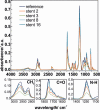Characterization of Partially Covered Self-Expandable Metallic Stents for Esophageal Cancer Treatment: In Vivo Degradation
- PMID: 33709689
- PMCID: PMC8045022
- DOI: 10.1021/acsbiomaterials.0c01773
Characterization of Partially Covered Self-Expandable Metallic Stents for Esophageal Cancer Treatment: In Vivo Degradation
Abstract
Partially covered self-expandable metallic esophageal stent (SEMS) placement is the most frequently applied palliative treatment in esophageal cancer. Structural characterization of explanted 16 nitinol-polyurethane SEMS (the group of 6 females, 10 males, age 40-80) was performed after their removal due to dysfunction. The adverse bulk changes in the polymer structure were identified using differential scanning calorimetry (DSC), differential mechanical thermal analysis (DMTA), and attenuated total reflectance infrared spectroscopy (ATR-IR) and discussed in terms of melting point shift (9 °C), glass-transition shift (4 °C), differences in viscoelastic behavior, and systematic decrease of peaks intensities corresponding to C-H, C═O, and C-N polyurethane structural bonds. The scanning electron and confocal microscopic observations revealed all major types of surface degradation, i.e., surface cracks, peeling off of the polymer material, and surface etching. The changes in the hydrophobic polyurethane surfaces were also revealed by a significant decrease in wettability (74°) and the corresponding increase of the surface free energy (31 mJ/m2). To understand the in vivo degradation, the in vitro tests in simulated salivary and gastric fluids were performed, which mimic the environments of proximal and distal ends, respectively. It was concluded that the differences in the degradation of the proximal and distal ends of prostheses strongly depend on the physiological environment, in particular stomach content. Finally, the necessity of the in vivo tests for SEMS degradation is pointed out.
Keywords: biomaterial; esophageal cancer; esophageal stent; esophagus; in vivo degradation; polyurethane.
Conflict of interest statement
The authors declare no competing financial interest.
Figures












Similar articles
-
Predictors of stent dysfunction after self-expandable metal stent placement for malignant gastric outlet obstruction: tumor ingrowth in uncovered stents and migration of covered stents.Surg Endosc. 2017 Oct;31(10):4165-4173. doi: 10.1007/s00464-017-5471-7. Epub 2017 Mar 9. Surg Endosc. 2017. PMID: 28281116
-
Fully vs. partially covered selfexpandable metal stent for palliation of malignant esophageal strictures: a randomized trial (the COPAC study).Endoscopy. 2018 Oct;50(10):961-971. doi: 10.1055/a-0620-8135. Epub 2018 Jun 12. Endoscopy. 2018. PMID: 29895072 Clinical Trial.
-
Outcome and risk factors assessment for adverse events in advanced esophageal cancer patients after self-expanding metal stents placement.Dis Esophagus. 2017 Feb 1;30(3):1-6. doi: 10.1111/dote.12467. Dis Esophagus. 2017. PMID: 27629280
-
Stent migration following endoscopic suture fixation of esophageal self-expandable metal stents: a systematic review and meta-analysis.Surg Endosc. 2018 Feb;32(2):675-681. doi: 10.1007/s00464-017-5720-9. Epub 2017 Jul 19. Surg Endosc. 2018. PMID: 28726147
-
A Review of Self-Expanding Esophageal Stents for the Palliation Therapy of Inoperable Esophageal Malignancies.Biomed Res Int. 2019 Apr 4;2019:9265017. doi: 10.1155/2019/9265017. eCollection 2019. Biomed Res Int. 2019. PMID: 31080835 Free PMC article. Review.
Cited by
-
Manufacturing, Processing, and Characterization of Self-Expanding Metallic Stents: A Comprehensive Review.Bioengineering (Basel). 2024 Sep 29;11(10):983. doi: 10.3390/bioengineering11100983. Bioengineering (Basel). 2024. PMID: 39451359 Free PMC article. Review.
-
Advances in the development of biodegradable coronary stents: A translational perspective.Mater Today Bio. 2022 Jul 19;16:100368. doi: 10.1016/j.mtbio.2022.100368. eCollection 2022 Dec. Mater Today Bio. 2022. PMID: 35937578 Free PMC article. Review.
References
-
- Naghavi M.; Abajobir A. A.; Abbafati C.; Murray C. J. L.; et al. Global, regional, and national age-sex specifc mortality for 264 causes of death, 1980-2016: A systematic analysis for the Global Burden of Disease Study 2016. Lancet 2017, 390, 1151–1210. 10.1016/S0140-6736(17)32152-9. - DOI - PMC - PubMed
-
- Todua F.; Gagua R.; Maglakelidze M.; Maglakelidze D. Cancer incidence and mortality – Major patterns in GLOBOCAN 2012, worldwide and Georgia. Bull. Georgian Natl. Acad. Sci. 2015, 9, 168–173.
-
- Yuan T.; Zheng R.; Yu J.; Edmonds L.; Wu W.; Cao J.; Gao F.; Zhu Y.; Cheng Y.; Cui W. Fabrication and evaluation of polymer-based esophageal stents for benign esophagus stricture insertion. RSC Adv. 2016, 6, 16891–16898. 10.1039/C5RA23763G. - DOI
Publication types
MeSH terms
LinkOut - more resources
Full Text Sources
Other Literature Sources
Medical
Miscellaneous

